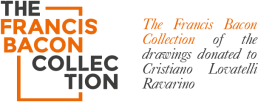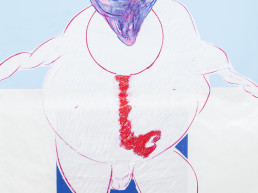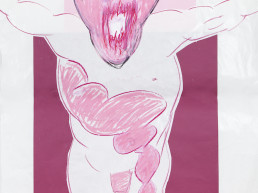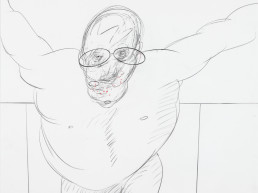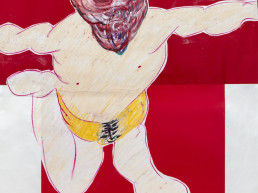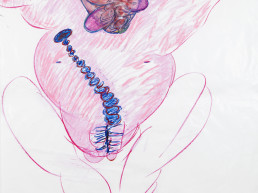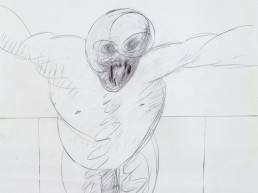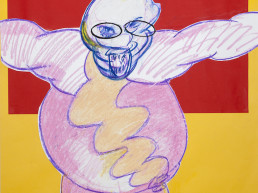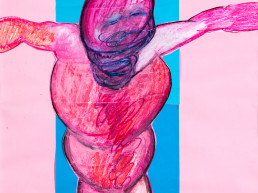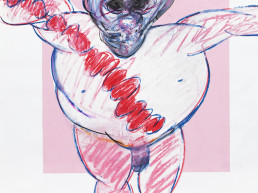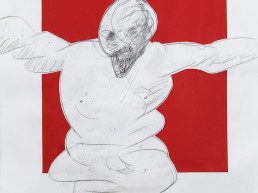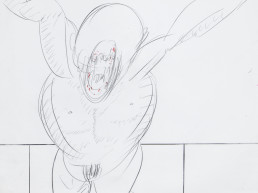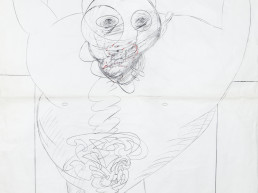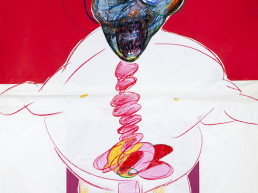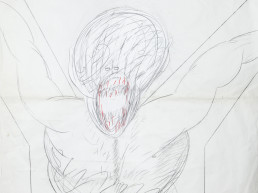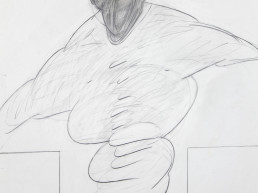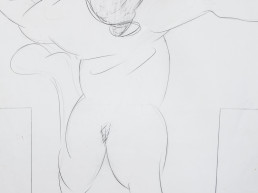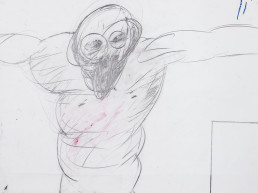-
francis
bacon
-
21 jan / 21 feb.2016
-
palazzo montanari
via galliera, 8
bologna
Since 1927, when at the age of 16, Francis Bacon had decided to “try” and become a painter, for all his life he had the image of crucifixion in front of his eyes.
Which he painted more than one time.
Not only the upside down one by Cimabue, of which he kept a reproduction in his London studio; but also the “sadomasochistic” one by his friend and teacher Roy de Maistre, nowadays found at the Leicester Museum; and particularly the one by Grunewald, now at the Musée d’Unterlinden in Colmar.
There have been more, just as important.
Daniel Farson remembers a charcoal sketch by Picasso seen at the Rosenberg Gallery in Paris in 1927 which deeply influenced him to the point that “it is impossible to deny that he drew inspiration from it, especially for Three Studies at the Base of a Crucifixion dated 1944.
And it is a real pity that nothing more than an image stuck on Molly Craven’s memory is what’s left of a wall painting inspired by crucifixion which she saw in his bedroom when he was living at n.1 Glebe Place, Chelsea, in 1937.
Which is very precise in her description anyway.
“There was a painting which warned about his future works. Mollie Craven saw it one winter Sunday when she went up to his studio and she heard him in the grip of a scary cough. She followed his voice up until his bedroom, “a room with dark blue walls and ceiling and a huge wall painting with a crucified arm on the wall opposite him, terrifying, letting you feel a shiver run down your spine.” Mollie thought the wall painting had been inspired by Durer’s Crucifixion but most probably it was Grunewald’s Crucifixion of 1515 made for the altarpiece in Isenheim, which greatly influenced both the Crucifixion by Francis and the work Graham Sutherland realized for the church of St.Matthews in Northampton.” It was a big left arm full of nails and only a sketch of the thorax which pointed towards the window. In fact the body was cut from the chimney’s shelf. A real torture chamber” ( Daniel Farson, Francis Bacon. A golden life in the slums. 2011, Johan&Levi, pg. 48).
A plastic image, the one drawn by Mollie Craven’s memory, very different from the first Crucifixions painted by Francis Bacon in 1933 and even more different from his masterpiece Three Studies at the Base of a Crucifixion dated 1944 and exhibited at the Tate in London.
Different also from the Crucifixion dated 1946 and from the remake of Three Studies at the Base of Crucifixion dated 1944 and taken up in a completely different way in 1962. Why was Francis Bacon so interested in the Crucifixion?
Why is a painter who refers himself to as a “non-religious person” so attracted to the most Christian of all symbols?
The answer is given by Francis Bacon himself to David Sylvester during one of his famous “Interviews”.
EXHIBITED ARTWORKS
Some of the works belonging to the Francis Bacon Collection exhibited at Palazzo Montanari in Bologna.
-
francis
bacon
-
21 jan / 21 feb.2016
-
palazzo montanari
via galliera, 8
bologna
This is what Francis Bacon says (go to the interviews)
INTERVIEW 1
DS: …when you choose a theme like Crucifixion, you seem to be looking for deeply dramatic subjects…
FB: I have always been very attracted by images related to slaughterhouses and flesh. I think they are tightly connected to the Crucifixion. I have seen some extraordinary pictures of animals taken the moment before they were killed; and the smell of death… Of course we do not know for sure, but looking at these pictures it seems that they are aware of what is about to happen to them… They try to escape in any possible way. I believe these images show something that is very very close to the Crucifixion incident. I know that for religious people, for Christians, Crucifixion has a totally different meaning. But for a non-believer like me, it is only a human behavior, a way of behaving towards others.
DS: Well, in fact, beyond the Crucifixion, which has been one of your recurrent themes for about thirty years, you also paint other images related to religion, Popes for example. Can you say why you constantly depict images connected to religion?
FB: Concerning Popes, religion has nothing to do with it; they are rather the result of an obsession for the photographic reproductions of Pope Innocent X’s portrait by Velasquez.
INTERVIEW 2
DS: Was it in your intention to try and create a tragic kind of art?
FB: No. Well, of course I think it would be really useful if nowadays we could find a valid myth, where you can see that distance between majesty and its decline which is present in Aeschylus and also in Shakespeare’s tragedies. But when you have come away from tradition, just like contemporary artists have done, you can only aspire to record your feelings with regards to some situations though keeping yourself very close to your nervous system.
DS: Obviously there is a big mythological and tragic theme linked to tradition that you have depicted many times, and that is Crucifixion.
FB: Well, European Art has a long tradition of portrayals regarding Crucifixion, so much so that it becomes a great armor on which to graft any kind of feelings and sensations. You could think it strange for a non-religious person to adopt the Crucifixion theme, but I believe religion has nothing to do with it here. Just think about the big Crucifixions we know about…we do not know whether they were depicted by men with a religious belief or not.
DS: Yes, but they were depicted as part of the Christian culture and they were meant for believers.
FB: That is true. It could sound like an unfulfilled answer, but so far I have not found a subject as valid to embrace all the nuances of human feelings and behaviors. Perhaps this is because so many artists have dealt with this subjects that an armor has been created around which – I cannot find any better word to say it – you can activate just about any sensitive level.
DS: Of course, when facing this problem, many modern artists who work in the various creative fields, have fallen back on the Greek myths. You, yourself, working at Three Studies at the Base of a Crucifixion, have not depicted the most traditional Christian figures at the cross’ feet, but rather the Eumenides. Have you ever thought about using other themes from Greek mythology?
FB: Well, I think Greek mythology is far from us, even further that Christianity. One of key aspects of the Crucifixion is the fact that the central figure of Christ is positioned very high up and isolated from the rest, and this, from a formal point of view, offers more possibilities than having all figures on the same level. The level variation is, from my point of view, very important.
DS: When you depict a crucifixion, do you find that your approach to the problem is radically different from the one you have when working on other subjects?
FB: Well, of course then you are working with your own feelings and sensations. You could say that one is very close to a self-portrait. There are all sorts of very personal feelings on behavior and on how life is, playing there.
DS: A very personal configuration recurrent in your works is the interweaving of Crucifixion iconography with that one of a slaughterhouse. The relationship with flesh must mean a lot to you.
FB: Yes, of course. If you go to one of those big selling points and you cross those enormous death rooms, you see nothing but animals, fish and birds, and they are all lying there, dead. And of course, because I am a painter, I cannot forget the beauty of flesh color.
DS: The matching between flesh and Crucifixion seems to happen in two ways: through the presence of the quarters of meat on the scene and through the transformation of the crucified figure into a hanging carcass.
FB: Well, of course. We are meat, potential carcasses. Every time I go into a butcher’s I am astonished for not being there in place of that animal. But that particular use of meat is a bit like the use one could make of the backbone: because we are constantly bombarded by body images seen through the x-rays, it is obvious that this affects the way you use your own body….
DS: It is clear that your obsession on depicting flesh is mostly connected to shape and color…this is evident from the works themselves. However the works of Crucifixion are certainly the ones that have persuaded the critics to talk about the so-called element of “horror” in your paintings.
FB: Well, surely they’ve always underlined this horror element, but honestly I don’t see it so clearly. I have never tried to be so horrifying. You only need to look at things and know the background to realize that what I have been able to produce hasn’t highlighted this aspect of life. When you go into a butcher’s and you take notice of how beautiful meat can be and then you ponder about it, you can then go on thinking about all life’s horror: that one thing lives thanks to another. Just think about all those stupid things they say about bullfights. People eat meat and then they condemn bullfights; they go complaining about bullfights wearing furs and with birds in their hair.
INTERVIEW 4
DS: Three Studies for Figures at the Base of a Crucifixion dated 1944 is made of clearly defined plastic figures which are ready to be transformed into sculptures.
FB: Well, I thought about them as the Eumenides, and at that time I had the whole Crucifixion in my head, and they would have been part of it in the place of the usual figures at the feet of the cross. I wanted to position them inside an armor around the cross, which would have been placed higher, with the cross’ image in the center and these figures all around it. But I never made it; I left the figures at their initial step of being an attempt.
These are Bacon’s answers.
But there is another question which we must ask ourselves: why does Francis Bacon, whose last Crucifixion is from 1962, depict some dozens of them between 1977 and 1992?
We are talking about pastels, collage and pencil drawings.
This time Francis Bacon cannot give us an answer because nobody was able to ask him.
Not only because he died in 1992, but because, as we all know, during all his life and even a few years after his death the myth that he painted straight on canvas has kept hold, against all evidence.
A myth which Bacon himself contributed to create and that his commentators have never contradicted despite knowing the truth.
It is long known that Francis Bacon drew and that he constantly did it: a fact which nobody can deny anymore.
Edward Lucie Smith – the first art historian who since 1999 has recognized the truth of the drawings – has given an apparently more convincing answer which does not regard only the Crucifixions but also all the paper works which are part of the collection Francis Bacon gifted to Cristiano Lovatelli Ravarino.
SHARE
-
francis
bacon
-
BIOGRAPHY
1909 Francis Bacon was born on October 28th, the second of five children, from English parents, Winifred and Edward Bacon. The father was a retired army captain who loved breeding horses and a descendant of the famous philosopher Francis Bacon. The asthma made it difficult for Francis to attend school so he was occasionally educated by a local priest.
1914-1925 The family moves to London, where the father is called to work in the wiretapping office, then to Ireland by the maternal grandmother during the time of Sinn Fein. The future painter will keep a close contact in the years to follow with a friend he made at that time, Doreen Molony, who will later tell of how he could not stop drawing and sometimes he would hand her whole bundles asking for her opinion.
1926 After a series of violent discussions with his father, he moves to Berlin for a few weeks only to end up in Paris where he is particularly struck by an exhibition of Picasso’s drawings at the Paul Rosenberg Gallery. He starts producing drawings and watercolors.
1929 He returns to London and moves to a refitted garage at 17 Queensberry Mews West. He works as furniture designer. He meets the Australian painter Roy De Maistre and starts oil painting.
1933 He takes part in two collective exhibitions at the Mayor Gallery where he presents some crucifixions paintings, one of which will be reproduced in Art Now by Herber Read
1937 He takes part in the exhibition of the collective “Young English Artists” organized at the Agnew Gallery by Eric Hall.
1944-1954 He completes Three Studies for Figures at the Base of Crucifixion, started years before; the triptych will be displayed at the Lefèvre Gallery in London. He spends long periods of time in Montecarlo with Graham Sutherland. He writes to him from the Hotel Re di Montecarlo saying that he is simultaneously working on three drawings inspired by Velasquez portrait of Pope Innocent X. He represents England at the Venice Biennale together with Lucien Freud and Ben Nichols. He avoids going to the Biennale but he visits Ostia and Rome, where he stays at Palazzo Pecci Blunt strolling around the city with his friend, the painter Leonardo Cremonini, on his motorbike.
1957 He spends sometime in Tangeri. Jean Lacarde, director of the Rive Gauche Gallery, manages the artist’s first solo exhibition in Paris together with Erica Brausen.
1960 His solo exhibition at the Marlborough Gallery in London with over thirty works from 1959 to 1960 is extremely successful.
1961 He moves into a studio above a garage in Reece Mews, South Kensington, where he will live and work for the rest of his life.
1971 In April in Paris he has his most important solo exhibition at the Grand Palais, his mother dies the same month. Connaissance des Arts puts him at the first place among the ten most important painters in the world, a rank which the magazine reviews every five years.
1974 Bacon meets John Edwards who will become his life companion and universal heir, in a kind of father-and-son-relationship.
1977 He visits Balthus in Rome for his farewell party from the management of Villa Medici.
1988 Twenty-two works from the artist are exhibited at the Artist House in Moscow; this is the first exhibition ever granted to a European living artist.
1989 During an interview to Art International he admits to drawing sketches on canvas before painting on it, even though the final work almost never complies with the original one.
1990 Bacon goes to Sicily to visit two old friends, Erica Brausen and Leonardo Cremonini together with his new lover, a rich and awesome young Spanish guy.
1992 Bacon dies in complete solitude on April 28th at the Ruber Clinic in Madrid.
